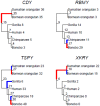Ampliconic Genes on the Great Ape Y Chromosomes: Rapid Evolution of Copy Number but Conservation of Expression Levels
- PMID: 32374870
- PMCID: PMC7313670
- DOI: 10.1093/gbe/evaa088
Ampliconic Genes on the Great Ape Y Chromosomes: Rapid Evolution of Copy Number but Conservation of Expression Levels
Abstract
Multicopy ampliconic gene families on the Y chromosome play an important role in spermatogenesis. Thus, studying their genetic variation in endangered great ape species is critical. We estimated the sizes (copy number) of nine Y ampliconic gene families in population samples of chimpanzee, bonobo, and orangutan with droplet digital polymerase chain reaction, combined these estimates with published data for human and gorilla, and produced genome-wide testis gene expression data for great apes. Analyzing this comprehensive data set within an evolutionary framework, we, first, found high inter- and intraspecific variation in gene family size, with larger families exhibiting higher variation as compared with smaller families, a pattern consistent with random genetic drift. Second, for four gene families, we observed significant interspecific size differences, sometimes even between sister species-chimpanzee and bonobo. Third, despite substantial variation in copy number, Y ampliconic gene families' expression levels did not differ significantly among species, suggesting dosage regulation. Fourth, for three gene families, size was positively correlated with gene expression levels across species, suggesting that, given sufficient evolutionary time, copy number influences gene expression. Our results indicate high variability in size but conservation in gene expression levels in Y ampliconic gene families, significantly advancing our understanding of Y-chromosome evolution in great apes.
Keywords: Y chromosome; ampliconic genes; bonobo; gene copy number; gene expression; great apes; orangutan.
© The Author(s) 2020. Published by Oxford University Press on behalf of the Society for Molecular Biology and Evolution.
Figures







Similar articles
-
Transcript Isoform Diversity of Ampliconic Genes on the Y Chromosome of Great Apes.Genome Biol Evol. 2023 Nov 1;15(11):evad205. doi: 10.1093/gbe/evad205. Genome Biol Evol. 2023. PMID: 37967251 Free PMC article.
-
Dosage regulation, and variation in gene expression and copy number of human Y chromosome ampliconic genes.PLoS Genet. 2019 Sep 16;15(9):e1008369. doi: 10.1371/journal.pgen.1008369. eCollection 2019 Sep. PLoS Genet. 2019. PMID: 31525193 Free PMC article.
-
The complete sequence and comparative analysis of ape sex chromosomes.Nature. 2024 Jun;630(8016):401-411. doi: 10.1038/s41586-024-07473-2. Epub 2024 May 29. Nature. 2024. PMID: 38811727 Free PMC article.
-
The Y chromosomes of the great apes.Hum Genet. 2017 May;136(5):511-528. doi: 10.1007/s00439-017-1769-8. Epub 2017 Mar 6. Hum Genet. 2017. PMID: 28265767 Review.
-
Great ape genomics.ILAR J. 2013;54(2):82-90. doi: 10.1093/ilar/ilt048. ILAR J. 2013. PMID: 24174434 Free PMC article. Review.
Cited by
-
The first complete T2T Assemblies of Cattle and Sheep Y-Chromosomes uncover remarkable divergence in structure and gene content.Res Sq [Preprint]. 2024 Apr 3:rs.3.rs-4033388. doi: 10.21203/rs.3.rs-4033388/v1. Res Sq. 2024. Update in: Nat Commun. 2024 Sep 27;15(1):8277. doi: 10.1038/s41467-024-52384-5. PMID: 38712074 Free PMC article. Updated. Preprint.
-
Fourth Report on Chicken Genes and Chromosomes 2022.Cytogenet Genome Res. 2022;162(8-9):405-528. doi: 10.1159/000529376. Epub 2023 Jan 30. Cytogenet Genome Res. 2022. PMID: 36716736 Free PMC article. Review. No abstract available.
-
Repetitive DNAs and differentiation of the ZZ/ZW sex chromosome system in the combtail fish Belontia hasselti (Perciformes: Osphronemidae).BMC Ecol Evol. 2025 Mar 18;25(1):25. doi: 10.1186/s12862-025-02358-y. BMC Ecol Evol. 2025. PMID: 40098070 Free PMC article.
-
The contribution of sex chromosome conflict to disrupted spermatogenesis in hybrid house mice.Genetics. 2022 Nov 30;222(4):iyac151. doi: 10.1093/genetics/iyac151. Genetics. 2022. PMID: 36194004 Free PMC article.
-
Detecting signatures of selection on gene expression.Nat Ecol Evol. 2022 Jul;6(7):1035-1045. doi: 10.1038/s41559-022-01761-8. Epub 2022 May 12. Nat Ecol Evol. 2022. PMID: 35551249
References
-
- Altschul SF, Gish W, Miller W, Myers EW, Lipman DJ.. 1990. Basic local alignment search tool. J Mol Biol. 215(3):403–410. - PubMed
-
- Ancrenaz M, et al.2016. Pongo pygmaeus. The IUCN Red List of Threatened Species 2016: e.T17975A123809220. Available from: https://dx.doi.org/10.2305/IUCN.UK.2016-1.RLTS.T17975A17966347.en. Accesed May 7, 2020.
-
- Boetzer M, Henkel CV, Jansen HJ, Butler D, Pirovano W.. 2011. Scaffolding pre-assembled contigs using SSPACE. Bioinformatics 27(4):578–579. - PubMed
Publication types
MeSH terms
Grants and funding
LinkOut - more resources
Full Text Sources
Research Materials
Miscellaneous

